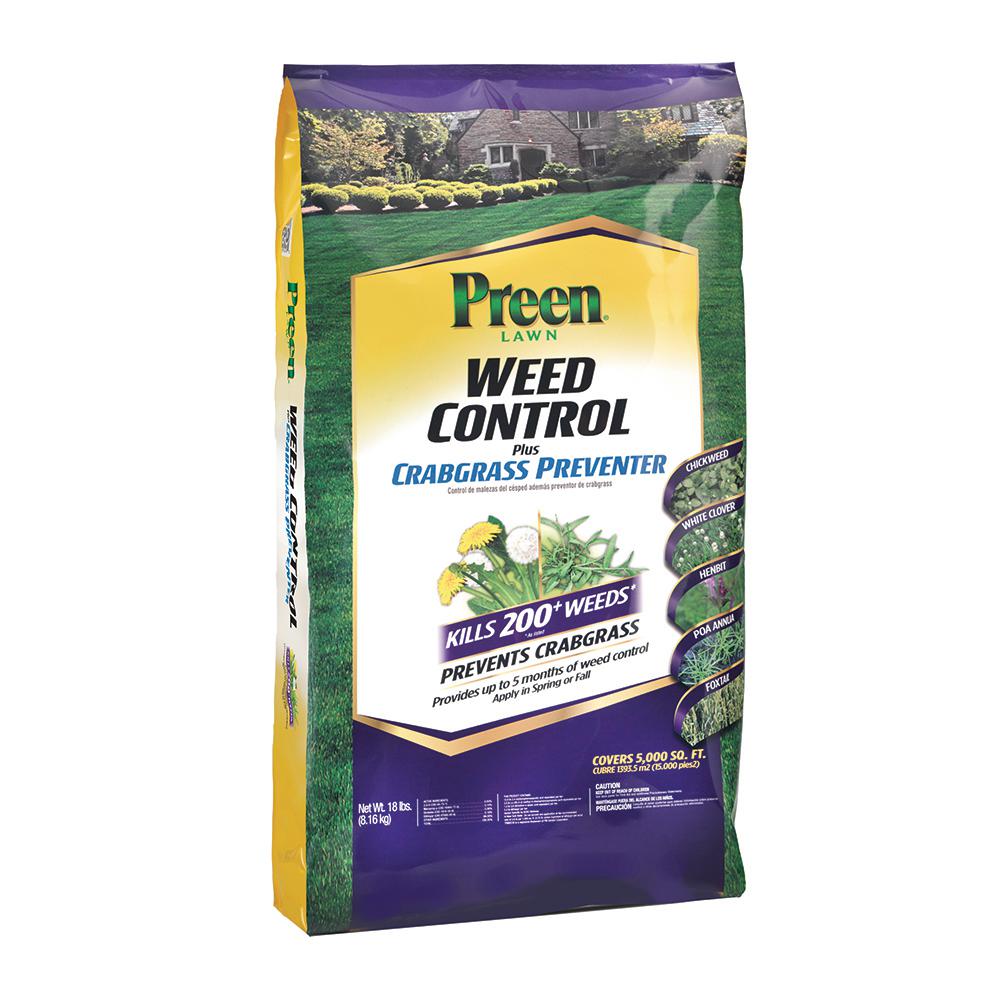Preen 24-64026 Lawn Weed Control Plus Crabgrass Preventer, 18 Lb, 5000
Description
Preen Lawn Weed Control Plus Crabgrass Preventer provides up to 5 months of weed control. This product kills over 200 broadleaf weeds like dandelions, clover, ground ivy, thistle, and chickweed, and prevents crabgrass and other undesirable annual grassy weeds. Formulated to be effective with cool and warm season grasses, Preen Lawn Weed Control Plus Crabgrass Preventer can be applied in spring or fall.
- Size: 18 Lbs
- Coverage: 5,000 Sq.ft.
- Lawn weed control plus crabgrass preventer
- Season long extended control
- Kills 200 tough weeds
- Prevents crabgrass and kills over 200 lawn weeds, including dandelion, chickweed, thistle and clover
- Provides up to 5 months of weed control
- Controls new weeds for 3 months
- Cool season grasses: Kentucky bluegrass, perennial ryegrass and fine and tall fescue.
- Warm season grasses: Bahaigrass, Bermudagrass, buffalograss, centipedegrass, zoysiagrass, St. Augustinegrass (except 'Floratam').
- Do not use this product on seedling buffalograss in the spring of the first year of establishment until the turfgrass is fully green and has established new roots.
- Bag.
Application
When to apply
- Apply Preen Lawn Weed Control Plus Crabgrass Preventer in spring or fall when grass and weeds are actively growing and the soil is moist. Do not apply under drought conditions.
- In spring, the best time to apply is when forsythia is in bloom or when dandelion flowers appear. In southern states, make a second application of Preen Lawn Weed Control Plus Crabgrass Preventer 6 to 8 weeks after the first for the best control.
- In fall, apply when the weather cools, but grass and weeds are still actively growing, usually around Labor Day.
How to apply
- Apply Preen Lawn Weed Control Plus Crabgrass Preventer when the grass is wet from dew or rain. Preen Lawn Weed Control Plus Crabgrass Preventer will not work well if applied to dry lawns.
- Apply Preen Lawn Weed Control Plus Crabgrass Preventer when wind is calm and there is no threat of rain for 24 hours. Delay mowing for 3 days after application.
- Use a drop or rotary spreader designed to apply granular fertilizers.
- Applying Around Not Well-Established Turfgrasses
Use of Preen Lawn Weed Control Plus Crabgrass Preventer on lawns and ornamental turfgrasses that are not well-established, or have been weakened by stress due to mechanical operations, pests, excessive temperatures, or lack of moisture, may increase the chances of turfgrass injury. It is advised that you do not apply this product to lawns or turfgrasses that are under stress.
If the lawn has been seeded recently, wait until after the third mowing before using this product. Do not seed or overseed the treated area for 10 weeks after application.
Weeds Controlled
- annual bluegrass (Poa annua)
- annual ryegrass (Lolium multiflorum)
- annual yellow sweetclover (Melilotus indicus)
- aster (Aster)
- Austrian fieldcress
- barnyardgrass (Echinochloa crus-galli)
- bastardcabbage (Rapistrum rugosum)
- bedstraw
- beggarticks (Bidens frondosa)
- bird vetch (Vicia cracca)
- bitterweed
- black medic (Medicago lupulina)
- black mustard (Brassica nigra)
- blackeyed Susan (Rudbeckia hirta)
- blackseed plantain (Plantago rugelii)
- blessed thistle (Cnicus benedictus)
- bloodflower milkweed
- blue lettuce (Lactuca tatarica)
- blue vervain (Verbena hastata)
- bracted plantain
- brassbuttons (Cotula coronopifolia)
- bristly oxtongue (Picris echioides)
- broadleaf plantain (Plantago major)
- broomweed
- buckhorn plantain (Plantago lanceolata)
- bull thistle (Cirsium vulgare)
- bullnettle (Cnidoscolus texanus)
- burclover (Medicago polymorpha)
- burdock (Arctium minus)
- burning nettle (Urtica urens)
- burweed
- buttercup (Ranunculus californicus)
- buttonweed
- Canada thistle (Cirsium arvense)
- Carolina geranium (Geranium carolinianum)
- carpetweed (Mollugo verticillata)
- catchweed bedstraw (Galium aparine)
- catnip (Nepeta cataria)
- catsear (Hypochaeris)
- chickweed (Stellaria media)
- chicory (Cichorium intybus)
- cinquefoil (Potentilla)
- cockle
- cocklebur (Xanthium strumarium)
- common mallow (Malva neglecta)
- common mullein (Verbascum thapsus)
- Crabgrass (Digitaria sanguinalis)
- crimson clover (Trifolium incarnatum)
- crowfoot grass (Dactyloctenium aegyptium)
- cudweed
- curly dock (Rumex crispus)
- Daisy Fleabane (Erigeron strigosus)
- dandelion (Taraxacum officinale)
- dichondra
- dock
- dog fennel (Eupatorium capillifolium)
- dollarweed
- English daisy (Bellis perennis)
- false dandelion (Hypochaeris radicata)
- false sunflower
- falseflax (Camelina)
- fiddleneck (Amsinckia spp.)
- field bindweed (Convolvulus arvensis)
- Florida betony (Stachys floridana)
- Florida pusley (Richardia scabra)
- frenchweed (Thlaspi arvense)
- galinsoga (Galinsoga)
- goathead (Tribulus terrestris)
- goldenrod (Solidago spp.)
- goosegrass (Eleusine indica)
- green foxtail (Setaria viridis)
- ground ivy (Glechoma hederacea)
- gumweed
- hairy bittercress (Cardamine hirsuta)
- hairy fleabane
- hawkweed
- healall (Prunella vulgaris)
- heartleaf drymary
- heath aster (Aster ericoides var. ericoides)
- hedge bindweed (Calystegia sepium)
- hedge mustard (Sisymbrium officinale)
- henbit (Lamium amplexicaule)
- hoary cress
- hoary plantain (Plantago media)
- hoary vervain (Verbena stricta)
- hop clover
- horsenettle (Solanum carolinense)
- India mock strawberry
- jimsonweed (Datura stramonium)
- Kikuyu grass (Pennisetum clandestinum)
- knawel (Scleranthus annuus)
- kochia (Kochia scoparia)
- lambsquarters (Chenopodium album)
- lespedeza (Lespedeza cuneata)
- matchweed (Xanthocephalum gymnospermoides)
- Mexicanweed
- milk vetch
- mouseear chickweed (Cerastium fontanum ssp. vulgare)
- mouseear hawkweed (Hieracium pilosella var. niveum)
- mugwort (Artemisia vulgaris)
- musk thistle (Carduus nutans)
- mustard (Brassica spp.)
- narrowleaf plantain (Plantago lanceolata)
- narrowleaf vetch (Vicia sativa)
- nettle
- orange hawkweed (Hieracium aurantiacum)
- oriental cocklebur
- oxeye daisy
- parsley piert (Aphanes spp.)
- parsnip (Pastinaca sativa)
- pearlwort (Sagina)
- pennycress (Thlaspi arvense)
- pepperweed
- perennial ryegrass (Lolium perenne)
- pineappleweed (Matricaria discoidea)
- pineywoods bedstraw
- plains coreopsis (Coreopsis tinctoria)
- plantain (Plantago major)
- poison ivy (Toxicodendron radicans)
- Poison oak (Toxicodendron diversilobum)
- pokeweed (Phytolacca americana)
- poorjoe
- prairie sunflower (Helianthus petiolaris)
- prickly lettuce (Lactuca serriola)
- prickly sida (Sida spinosa)
- prostrate knotweed (Polygonum aviculare)
- prostrate pigweed (Amaranthus blitoides)
- prostrate spurge (Euphorbia supina)
- prostrate vervain (Verbena bracteata)
- puncturevine (Tribulus terrestris)
- purslane (Portulaca oleracea)
- ragweed (Ambrosia artemisiifolia)
- red clover (Trifolium pratense)
- red sorrel (Rumex acetosella)
- redroot pigweed (Amaranthus retroflexus)
- redstem filaree
- rough cinquefoil (Potentilla norvegica)
- rough fleabane (Erigeron strigosus)
- Russian pigweed (Axyris amaranthoides)
- scarlet pimpernel (Anagallis arvensis)
- Scotch thistle
- sheep sorrel (Oxalis stricta)
- shepherd's purse (Capsella bursa-pastoris)
- slender plantain
- smallflower galinsoga
- smooth dock (Rumex altissimus)
- smooth pigweed (Amaranthus hybridus)
- smutgrass (Sporobolus indicus)
- sorrel
- sow thistle (Sonchus oleraceus)
- spanishneedles
- speedwell (Veronica)
- spiny amaranth (Amaranthus spinosus)
- spiny cocklebur (Xanthium spinosum)
- spiny-leaf sow-thistle (Sonchus asper)
- spotted catsear (Hypochaeris radicata)
- spotted spurge (Chamaesyce maculata)
- spurweed
- stinging nettle (Urtica dioica)
- strawberry clover (Trifolium fragiferum)
- sweet clover (Melilotus)
- tall nettle (Urtica dioica)
- tall vervain (Verbena stricta)
- tansy ragwort (Senecio jacobaea)
- tansymustard (Descurainia pinnata)
- tanweed (Polygonum amphibium var. emersum)
- trailing crownvetch
- tumble mustard (Sisymbrium altissimum)
- tumble pigweed (Amaranthus albus)
- velvetleaf (Abutilon theophrasti)
- Venice mallow (Hibiscus trionum)
- Virginia buttonweed
- Virginia creeper
- Virginia pepperweed (Lepidium virginicum)
- wavyleaf bullthistle
- western clematis
- western salsify (Tragopogon dubius)
- white clover (Trifolium repens)
- white mustard (Sinapis alba)
- wild aster
- wild buckwheat (Polygonum convolvulus)
- wild carrot (Daucus carota)
- wild four-o'clock (Mirabilis nyctaginea)
- wild garlic (Allium vineale)
- wild geranium
- wild lettuce
- wild marigold (Tagetes minuta)
- wild mustard (Sinapis arvensis)
- wild onion
- wild parsnip (Pastinaca sativa)
- wild radish (Raphanus raphanistrum)
- wild sweet potato
- wild vetch
- woodsorrel (Oxalis spp.)
- woolly croton (Croton capitatus)
- woolly morningglory
- woolly plaintain
- wormseed
- yarrow (common) (Achillea millefolium)
- yellow foxtail (Setaria glauca)
- yellow rocket (Barbarea vulgaris)
- yellowflower pepperweed

